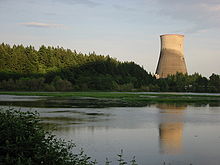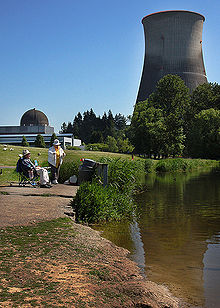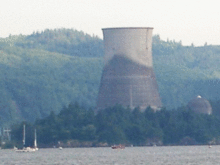- Trojan Nuclear Power Plant
-
Trojan Nuclear Power Plant 
The Trojan Nuclear Power Plant shortly before demolitionLocation Columbia County, near Rainier, Oregon, USA Coordinates 46°2′18″N 122°53′6″W / 46.03833°N 122.885°WCoordinates: 46°2′18″N 122°53′6″W / 46.03833°N 122.885°W Status Decommissioned Construction began 1970 Commission date May 20, 1976 Decommission date 1992 Construction cost Approximately $500,000,000 Operator(s) Portland General Electric Architect(s) Bechtel Reactor information Reactor type(s) Pressurized water reactor (PWR) Reactor supplier(s) Westinghouse Power station information Generation units General Electric Power generation information Installed capacity 1,130 MW Trojan Nuclear Power Plant was a pressurized water reactor nuclear power plant located southeast of Rainier, Oregon, United States, and the only commercial nuclear power plant to be built in Oregon. After sixteen years of service it was closed by its operator, Portland General Electric (PGE),[1] almost twenty years before the end of its design lifetime.[citation needed] Decommissioning and demolition of the plant began in 1993 and was completed in 2006.[2]
While operating, Trojan represented more than 12% of the electrical generation capacity of Oregon. For comparison, more than 80% of Oregon's electricity came from hydropower from dams on the Columbia and Snake Rivers, with the rest mainly from fossil fuels.[citation needed] The site lies directly south of the small city of Prescott, on the banks of the Columbia River.
Contents
History
Construction of Trojan began February 1, 1970. First criticality was achieved on December 15, 1975 and grid connection on December 23, 1975. Commercial operation began on May 20, 1976 under a 35-year license to expire in 2011. The single 1130 megawatt unit at Trojan was then the largest pressurized water reactor built. It cost $450 million to build the plant.[citation needed]
Environmental opposition dogged Trojan from its inception, and the opposition included non-violent protests organized by the Trojan Decommissioning Alliance. The Alliance organized the first major direct action protest at Trojan in August 1977, and a second round of protests took place that November. Scores of demonstrators were arrested, and in December 1977 a jury found 96 protesters not guilty of criminal trespass. There was another protest in August 1978, which led to about 280 arrests.[3]
In 1978, the plant was closed for nine months while modifications were made to improve its resistance to earthquakes[citation needed]. This followed the discovery both of major building construction errors and of the close proximity of a previously unknown faultline [4]. The operators sued the builders, and an undisclosed out-of-court settlement was eventually reached[citation needed].
The Trojan steam generators were designed to last the life of the plant, but it was only four years before premature cracking of the steam tubes was observed[citation needed].
In the 1980 Oregon election, a ballot measure to ban construction of further nuclear power plants in the state without federally approved waste facilities was approved by the voters 608,412 (53.2%) to 535,049 (46.8%).[5] In 1986, a ballot measure initiated by Lloyd Marbet for immediate closure of the Trojan plant was failed 35.7% yes to 64.3% no.[6] This proposal was resubmitted in 1990, and again in 1992 when a similar proposal (by Jerry and Marilyn Wilson) to close the plant was also included. Each measure was soundly defeated by vote margins over 210,000 votes.[7][8][9] Although all closure proposals were defeated, the plant operators committed to successively earlier closure dates for the plant.
In 1992, Portland General Electric (PGE) spent $4.5 million to defeat ballot measures seeking to close Trojan.[10] It was the most expensive ballot measure campaign in Oregon history until the tobacco industry spent $12 million in 2007 to defeat Measure 50.[11] A week later the Trojan plant suffered another steam generator tube leak of radioactive water, and was shut down[citation needed]. It was announced that replacement of the steam generators would be necessary. In December 1992, documents were leaked from the U.S. Nuclear Regulatory Commission showing that staff scientists believed that Trojan might be unsafe to operate[citation needed]. In January 1993, chief plant engineer David Fancher, acting as spokesman for PGE, announced the company would not try to restart Trojan.[citation needed]
The spent fuel was transferred from cooling pools to 34 concrete and steel storage casks in 2003. [12]
In 2005, the reactor vessel and other radioactive equipment were removed from the Trojan plant, encased in concrete foam, shrink-wrapped, and transported intact by barge along the Columbia River to Hanford Nuclear Reservation in Washington, where it was buried in a 45-foot-deep (14 m) pit and covered with 6 inches (150 mm) of gravel, which made it the first commercial reactor to be moved and buried whole.[13] The spent fuel is stored onsite in 34 dry casks[14]. It was awaiting transport to the Yucca Mountain Repository until that project was canceled in 2009[15].
The iconic 499-foot-tall (152 m) cooling tower, visible from Interstate 5 in Washington and U.S. Route 30 in Oregon, was demolished via dynamite implosion at 7:00 a.m. on May 21, 2006. This event marked the first implosion of a cooling tower at a nuclear plant in the United States[citation needed]. Additional demolition work on the remaining structures continued through 2008. The central office building, and the reactor building were demolished by Northwest Demolition and Dismantling[16] in 2008. Remaining are five buildings: two warehouses, a small building on the river side, a guard shack, and offices outside the secured facility. There is also extensive underground infrastructure still to be demolished. It is expected that demolition of the plant will cost as least as much as its construction.[citation needed]
Heliport
Trojan Heliport (FAA LID: 3OR7) is a 60 x 60 ft. (18 x 18 m) private turf heliport located at the power plant.[17]
References
- ^ Koberstein, Paul (2005-03-09). "Trojan: PGE's Nuclear Gamble". Willamette Week. p. A1. http://www.wweek.com/editorial/3118/6073/. Retrieved 2007-06-15.
- ^ "Trojan Nuclear Plant Decommissioning Update" (PDF). Issues in Perspective. Portland General Electric. March 2006. http://www.portlandgeneral.com/about_PGE/corporate_info/trojan/images/issues_in_perspective.pdf. Retrieved 2008-04-06.[dead link]
- ^ Daniel Pope. Anti-Nuclear Movement The Oregon Encyclopedia.
- ^ Beaulieu and Peterson, [1] "St Helens area relative to the Trojan nuclear site" Dec 1981
- ^ Oregon Blue Book. Initiative, Referendum and Recall: 1980-1987. November 4, 1980 - "Nuclear Plant Licensing Requires Voter Approval, Waste Disposal Facility Existence".
- ^ Oregon Blue Book. Initiative, Referendum and Recall: 1980-1987. November 4, 1986 - "Prohibits Nuclear Power Plant Operation Until Permanent Waste Site Licensed".
- ^ Oregon Blue Book. Initiative, Referendum and Recall: 1988-1995. November 6, 1990 - "Prohibits Trojan Operation Until Nuclear Waste, Cost, Earthquake Standards Met". Defeated 40.3% yes, 59.6% no.
- ^ Oregon Blue Book. Initiative, Referendum and Recall: 1988-1995. November 3, 1992 - "Closes Trojan Until Nuclear Waste, Cost, Earthquake, Health Conditions Met". Defeated 59.9% to 40.1%.
- ^ Oregon Blue Book. Initiative, Referendum and Recall: 1988-1995. November 3, 1992 - "Bans Trojan Power Operation Unless Earthquake, Waste Storage Conditions Met". Failed 42.7% yes to 57.3% no.
- ^ Anti-Nuclear Movement in the Oregon Encyclopedia
- ^ Malkin, Whitnes (November 8, 2007). "Tax defeat costs big tobacco big bucks". The Register-Guard.
- ^ Havrelly, Wayne (March 18, 2011). "Trojan's nuclear waste still on-site in steel, concrete casks". Northwest Cable News. http://www.nwcn.com/news/118237134.html.
- ^ "Trojan Nuclear Power Plant". Center for Land Use Interpretation. http://ludb.clui.org/ex/i/OR3142/. Retrieved 2008-12-03.
- ^ "Trojan spent fuel storage site". http://www.portlandgeneral.com/our_company/news_issues/current_issues/trojan_fuel.aspx. Retrieved 1 Aug 2011.
- ^ "GAO: Death of Yucca Mountain Caused by Political Maneuvering". New York Times. Aug 1, 2011. http://www.nytimes.com/gwire/2011/05/10/10greenwire-gao-death-of-yucca-mountain-caused-by-politica-36298.html?pagewanted=all. Retrieved 11 May 2011.
- ^ "Northwest Demolition and Dismantling". http://www.nwdemolition.com/. Retrieved 1 Aug 2011.
- ^ FAA. 30R7 form 5010.
External links
Portland General Electric information about the plant(Historic copy at Archive.org)- Local television news coverage of the implosion from many different angles
- High Country News article providing some of the time line of the plant
- Controlled-Demolition, the company that imploded the cooling tower.
- Resources for this airport:
- AirNav airport information for 3OR7
- FlightAware airport information and live flight tracker
- SkyVector aeronautical chart for 3OR7
Anti-nuclear movement in the United States General issues Anti-nuclear movement in California · Anti-nuclear groups in the United States · Anti-nuclear protests in the United States · Great Peace March for Global Nuclear Disarmament · List of cancelled nuclear plants in the United States · Nuclear power in the United States · Nuclear weapons and the United States ·
Organizations
and groupsAbalone Alliance · Clamshell Alliance · Committee for Nuclear Responsibility · Corporate Accountability International · Critical Mass · Friends of the Earth · Greenpeace USA · Institute for Energy and Environmental Research · Mothers for Peace · Musicians United for Safe Energy · Nevada Desert Experience · Nuclear Control Institute · Nuclear Information and Resource Service · Physicians for Social Responsibility · Plowshares Movement · Public Citizen · Shad Alliance · Sierra Club · Three Mile Island Alert · Women Strike for Peace ·People Daniel Berrigan · Larry Bogart · Helen Caldicott · Glenn Carroll · Barry Commoner · Frances Crowe · Carrie Barefoot Dickerson · Jane Fonda · John Gofman · Paul Gunter · John Hall · Amory Lovins · Arjun Makhijani · Gregory Minor · Ralph Nader · Linus Pauling · Eugene Rabinowitch · Bonnie Raitt · Martin Sheen · Karen Silkwood · Louie Vitale · Harvey Wasserman ·Main protest
sitesBlack Fox · Bodega Bay · Diablo Canyon · Indian Point · LLNL · Montague · Naval Base Kitsap · Nevada Test Site · Rancho Seco · Rocky Flats · San Onofre · Seabrook · Shoreham · Three Mile Island · Trojan · Vermont Yankee · Yankee RoweBooks Carbon-Free and Nuclear-Free · Conservation Fallout · Critical Masses · Fallout: An American Nuclear Tragedy · Killing Our Own · Licensed to Kill? · Making a Real Killing · Nuclear Implosions · Nuclear Politics in America · The Cult of the Atom · TMI 25 Years Later · We Almost Lost DetroitTopics in Oregon legislation Crime and sentencing Capital punishment · Measure 11 (1994) (mandatory minimum sentencing) · Measure 40 (1996) etc. (victims' rights) Abigail Scott Duniway was instrumental in establishing women's right to vote in Oregon.
Abigail Scott Duniway was instrumental in establishing women's right to vote in Oregon.
Elections and voting Gay rights Environment Land use Health care Minimum wage Taxation Tax revolt · Measure 5 (1990) (landmark tax law) · Measures 47 (1996) and 50 (1997) (adjusted Measure 5) · Kicker (tax rebate)Miscellaneous Influential people Background, further reading Categories:- Buildings and structures in Columbia County, Oregon
- Nuclear power plants in Oregon
- Former nuclear power stations in the United States
- Energy resource facilities in Oregon
- Scandals in Oregon
- Nuclear power stations using pressurized water reactors
Wikimedia Foundation. 2010.


